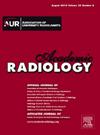Improving Prediction Accuracy of Residual Axillary Lymph Node Metastases in Node-Positive Triple-Negative Breast Cancer: A Radiomics Analysis of Ultrasound-Guided Clip Locations Using the SHAP Method
IF 3.8
2区 医学
Q1 RADIOLOGY, NUCLEAR MEDICINE & MEDICAL IMAGING
引用次数: 0
Abstract
Rationale and Objectives
To construct a radiomics nomogram derived from multiparametric ultrasound (US) imaging using the SHapley Additive exPlanations (SHAP) method for the accurate identification of residual axillary lymph node metastases post-neoadjuvant chemotherapy (NAC) among patients with triple-negative breast cancer (TNBC).
Methods
A total of 405 consecutive patients with pathologically confirmed TNBC between 2016 and 2023 were recruited in the study and were divided into training (n = 284) and validation cohorts (n = 121). Radiomics features capturing detailed tumor characteristics were extracted from pre-NAC gray-scale US images at the locations of US-guided clip placement. The least absolute shrinkage and selection operator and the maximum relevance minimum redundancy algorithm were employed to identify key features and formulate the radiomics signature (RS). A nomogram based on US radiomics was then constructed using multivariable logistic regression analysis. The predictive efficacy of this model was evaluated through receiver operating characteristic curve analysis, calibration assessment, and decision curve analysis. SHAP summary plots were used to visualize the distribution of SHAP values across all features.
Results
The nomogram integrates clinical and US characteristics with RS, yielded optimal AUC of 0.922 (95% CI, 0.890–0.954) in the training cohort, 0.904 (95% CI, 0.853–0.955) in the validation cohort. The calibration and decision curves confirmed favorable calibration and clinical value of the nomogram. SHAP provided further insight into the contributions of each feature to the model’s outcomes.
Conclusion
The combined multiparametric US based radiomics nomogram plays a potential role in predicting residual axillary lymph node metastases after NAC in TNBCs.
提高结节阳性三阴性乳腺癌残留腋窝淋巴结转移的预测准确性:使用SHAP方法对超声引导夹定位进行放射组学分析
理由和目标利用SHAPLE Additive exPlanations(SHAP)方法,从多参数超声(US)成像中构建放射组学提名图,用于准确识别三阴性乳腺癌(TNBC)患者新辅助化疗(NAC)后残留的腋窝淋巴结转移:研究共招募了405名2016年至2023年间经病理确诊的TNBC连续患者,并将其分为训练组(n = 284)和验证组(n = 121)。在 US 引导下放置夹子的位置,从 NAC 前灰度 US 图像中提取了捕捉详细肿瘤特征的放射组学特征。采用最小绝对收缩和选择算子以及最大相关性最小冗余算法来识别关键特征并制定放射组学特征(RS)。然后使用多变量逻辑回归分析构建了基于 US 放射组学的提名图。通过接收者操作特征曲线分析、校准评估和决策曲线分析,对该模型的预测效果进行了评估。SHAP汇总图用于直观显示所有特征的SHAP值分布:该提名图将临床和 US 特征与 RS 结合在一起,在训练队列中的最佳 AUC 为 0.922(95% CI,0.890-0.954),在验证队列中的最佳 AUC 为 0.904(95% CI,0.853-0.955)。校准和决策曲线证实了提名图良好的校准和临床价值。SHAP进一步揭示了每个特征对模型结果的贡献:基于美国多参数放射组学的组合提名图在预测 TNBC 患者 NAC 后残留腋窝淋巴结转移方面发挥了潜在作用。
本文章由计算机程序翻译,如有差异,请以英文原文为准。
求助全文
约1分钟内获得全文
求助全文
来源期刊

Academic Radiology
医学-核医学
CiteScore
7.60
自引率
10.40%
发文量
432
审稿时长
18 days
期刊介绍:
Academic Radiology publishes original reports of clinical and laboratory investigations in diagnostic imaging, the diagnostic use of radioactive isotopes, computed tomography, positron emission tomography, magnetic resonance imaging, ultrasound, digital subtraction angiography, image-guided interventions and related techniques. It also includes brief technical reports describing original observations, techniques, and instrumental developments; state-of-the-art reports on clinical issues, new technology and other topics of current medical importance; meta-analyses; scientific studies and opinions on radiologic education; and letters to the Editor.
 求助内容:
求助内容: 应助结果提醒方式:
应助结果提醒方式:


